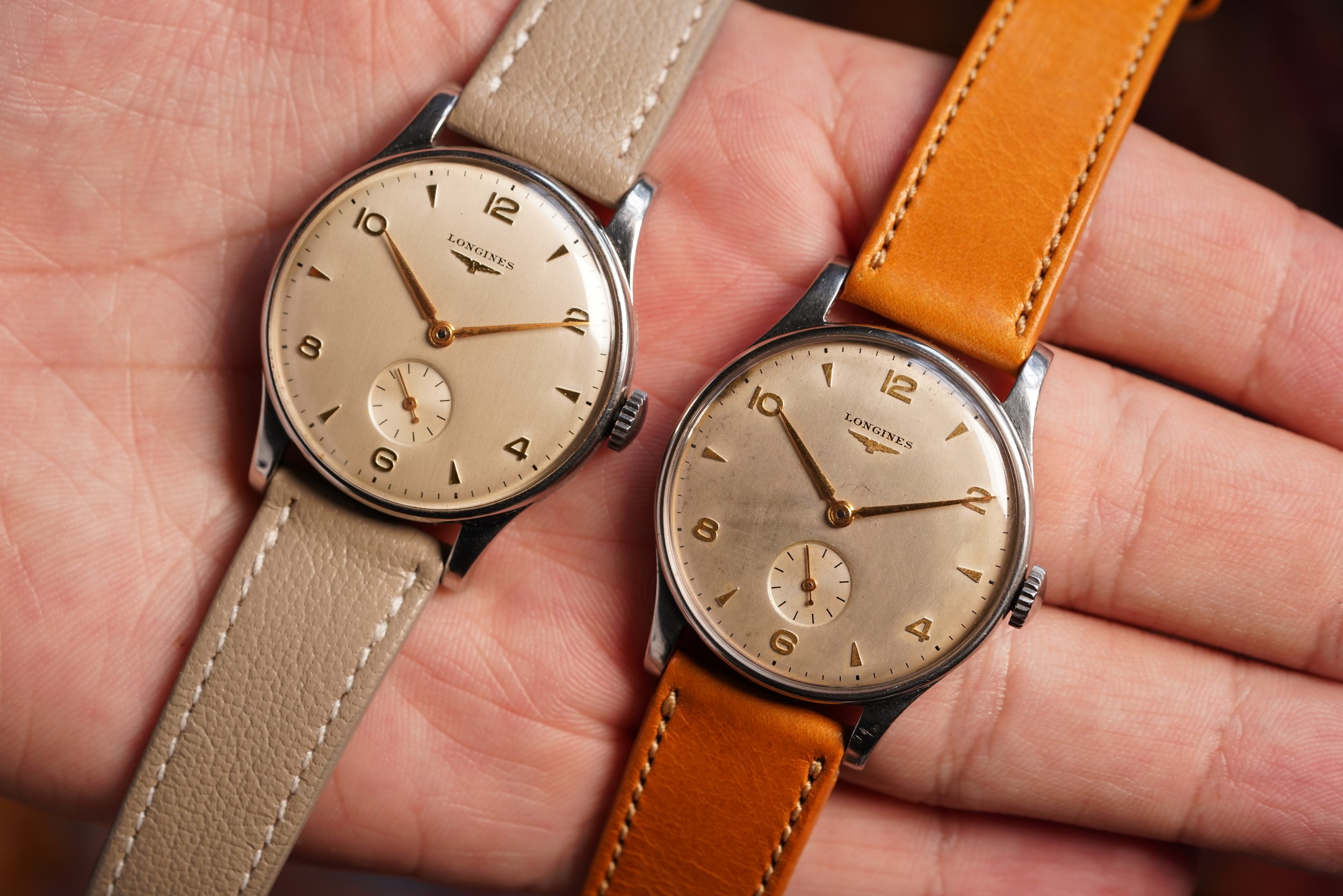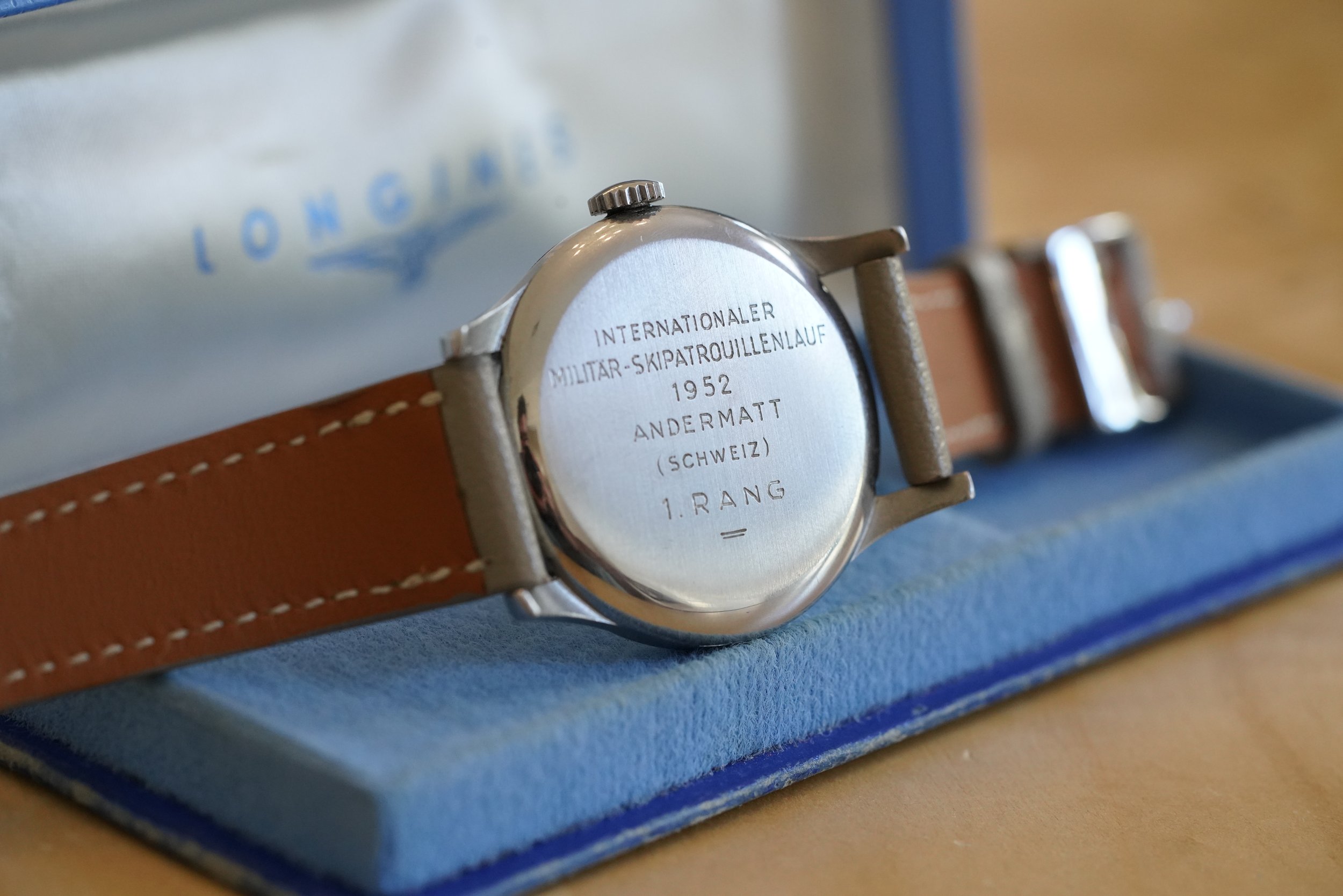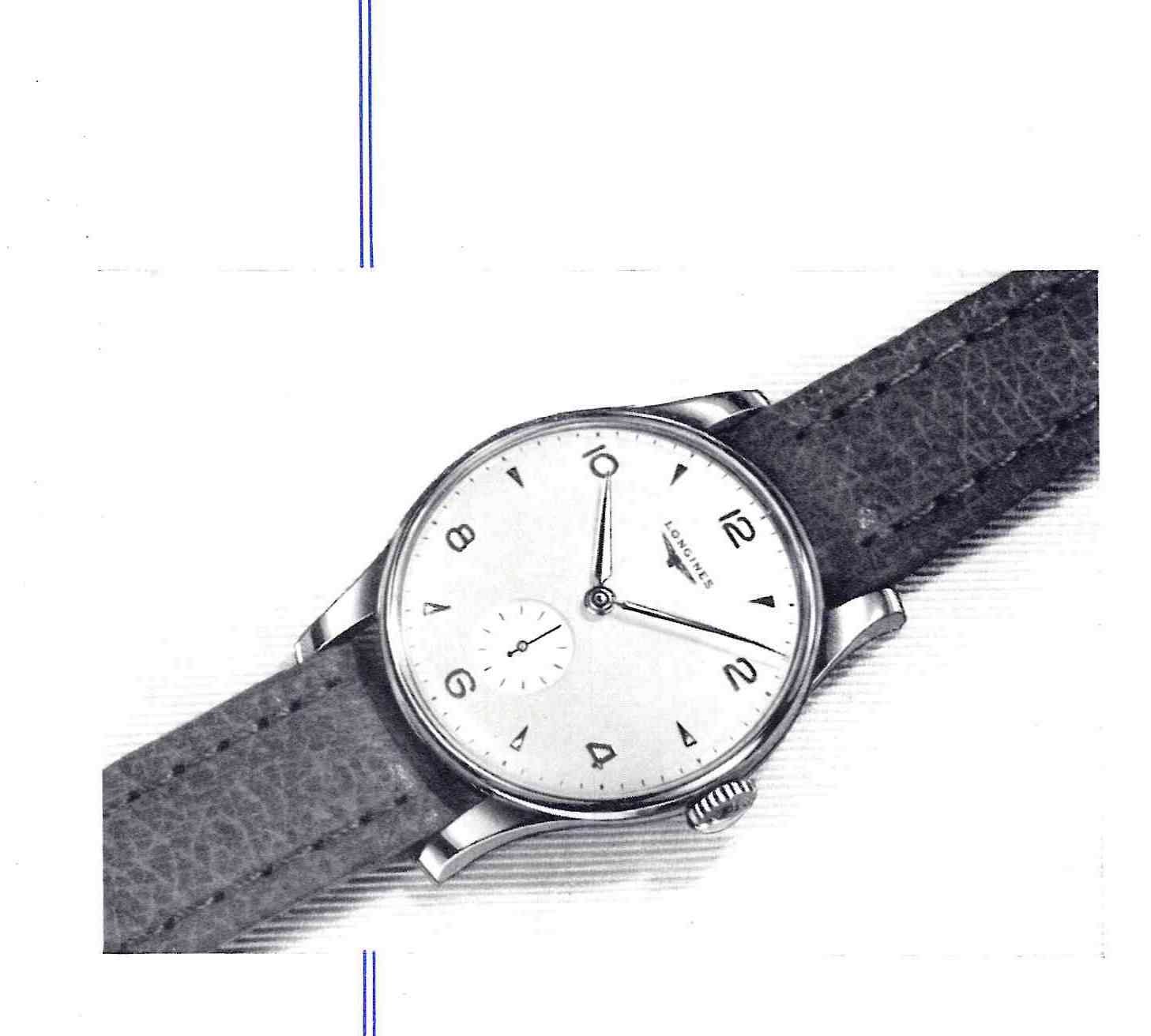The Longines Watches Awarded at The 1952 Winter Army Championships in Andermatt
by Charlie DunneEach timepiece has a story. Eric Wind recently emphasized how collectors ”get excited by watches that the original owners didn’t buy but earned.” The concept of a watch earned is somewhat of a forgotten tradition within modern society. The days of an employee spending decades at a company to eventually be recognized for their service with a commemorative timepiece is almost folklore in 2022. While it was more common throughout the 20th-century to earn a career-related timepiece, it was also quite common marketing practice for manufacturers to associate their products in industry, expedition, and sport.
Few manufacturers can compare to Longines in that they earned a reputation through not simply great marketing but unparalleled horological merit. Whether being the official timekeeper of the NFL during the 1950s, or their unrivaled technical achievements in aviation and avigation, Longines maintains one of the richest histories in the world of watchmaking.
1940s travel poster of Andermatt, Switzerland. Image credit: classicvintageposters.com
Longines Advertisement highlighting the Skiing scene. Image credit: L'Impartial, March 27, 1951
The following two Longines reference 5356 wristwatches share a story from the 1952 Winter Army Championships in Andermatt, a village located within the heart of the Swiss Alps. During the annual competition a Swedish soldier’s achievements in not one, but two trials earned him a pair of Longines reference 5356 timepieces. One wristwatch, earned by ranking 2nd in the International Military Single Ski Race, enjoyed a lifetime on the wrist. The second, earned by placing 1st with his team in the International Military Ski Patrol Run, was left unworn - as if with the intention to show future generations the original aesthetic of a watch produced in Saint Imier during the early 1950s.
Incredibly, both timepieces accompanied their original Longines presentation boxes. They also happen to be in the highly elusive sky-blue color with applied Longines branding on the exterior. The exterior features painted stars giving off a romantic impression of a midnight flight into a cloud-shaped winged-hourglass. The interior remains uncompromised which is very rare to see. It is quite apparent that the former owner took great pride in his awarded Longines watches by not only wearing one throughout his life but also keeping the additional timepiece unworn and boxes safe.
Although absent of the “VF” initials, it is likely the presentation box was made by Vuille & Cie, a Fribourg-based box manufacturer which was associated with several watch manufacturers such as Vulcain and Patek Philippe.
Image credit: Europa Star
The first of the two timepiece’s steel caseback shows signs of degradation, likely being worn on a leather-nato style strap. The applied hour markers consist of even-Arabic numerals and odd dagger markers. Each is slightly above 1mm tall, giving no dimension, but rather the aesthetic of painted markers.
Interestingly these servicemen were awarded more classic timepieces rather than the earlier screw-down caseback models such as the "Tre Tacche" and “Sei Tacche” of the 1940s. Also the 5356 would precede the more effective waterproof (or “Entache”) cases of the Conquest line by just a few years. As a result, the constant use throughout the decades in sporting situations at high altitudes has resulted in condensation contributing to the blemishes and imperfections throughout the dial, particularly a noticeable mark at 10 o’clock. The caseback reads:
“Internationaler Militar-Skieinzelllauf. 1952 Andermatt (Schweiz) 2. Rang”
(International Military Single Ski Race. 1952 Andermatt, Switzerland) 2nd place)
The first-place reference 5356 remains in pristine shape. The original vertically-brushed finish of the caseback remains in full view. The dial is preserved in Museum-grade condition. Like the aforementioned timepiece, the case has not been subject to a polish and highlights the true nature of the watch. The caseback reads:
“Internationaler Militar-Skipatrouillenlauf 1952 Andermatt (Schweiz) 1. Rang”
(International Military Ski Patrol Run 1952 Andermatt (Switzerland) 1st place)
Again, the watch features the iconic-applied winged hourglass and painted Longines branding. Gold-toned alpha hands complement the odd-dagger markers, while the subsidiary seconds feature a concentric-circle guilloche pattern.
1952 Italian Longines advertisement featuring a watch that closely resembles the reference 5356. Image credit: hifi-archiv.info
The reference 5356 is powered by the calibre 12.68Z, a manual wind movement with sub-seconds. The 12 ligne movement operates at 18,000 VPH and is comprised of 17 jewels. Between the two watches, they left the factory together within the same case batch only three cases apart, and their corresponding movements are two apart:
1st Place:
Case Number: 5356 14 497
Serial Number 8290066
2nd Place:
Case 5356 14 500
Serial Number 8290068
Image credit: watchguy.co.uk
1951 Longines advertisement featuring the calibre 12.68Z. Image credit: La Liberté.
A reference 5356 featured within an Italian Longines catalog from 1957. Images courtesy of vintagelongines.com
To further understand the origin of the timepieces, the Longines Heritage Department was able to provide insight through their records.
“The original serial numbers [8'290'066 and 8'290'068] identify [wristwatches] in stainless steel bearing the reference 5356. [They are] fitted with a Longines manually wound mechanical movement, caliber 12.68Z. [Both were] invoiced on 26 February 1952 to the company Wirth, which was at that time our agent for Switzerland.”
Both wristwatches would be invoiced on 2/26/1952 through the Swiss agent Wirth and would be delivered to the Andermatt Army Games during the following month.
Wirth & Cie a longtime agent for Longines in Switzerland. Image credit: L'Impartial July 31, 1919.
Researching the provenance carved into the timepieces unveiled the story Melker Risberg (also spelled Melcher). Born February 16, 1930, Risberg was a celebrated Swedish cross country skier who competed throughout Europe. He was recognized in several articles for his 2nd place in the International Singles Ski Race during the 1952 Die grossartigen Winter-Armeemeisterschaften in Andermatt (The great winter army championships in Andermatt). He would cover the 18-kilometer distance in a ranked time of 1:19:19 just behind his Swedish teammate Adolf Wiklund by merely 32 seconds.
“Swedish double victory in front of two Swiss: An exciting race developed, in which mainly the Swedes and the Swiss fought for the first [two] places. The two Swedes Wiklund and Risberg [were] a little better on the smooth cross-country ski run, and since they, like the best-ranked Swiss Lötscher and Roch, achieved the maximum in their shooting, the double victory could not be stolen from them. Results: 1. Technician Adolf Wiklund (Sweden) 1:18:47 (including 6:00 time credit) 2. Soldier Melkes Risberg (Sweden) 1:19:19 (6:00).” - Der Bund, Volume 103, Number 100, 29 February 1952
It is apparent that Risberg was not the only individual who received the 2nd rank in the Internationaler Militar-Skieinzelllauf, but also had earned the 1st in the patrouillenloauf (patrol run).
“The Norwegians fought desperately for the time equalizer over the remaining kilo bidders, but they were beaten by the Swedes by almost 25 seconds at the finish. In terms of running time, the Norwegian patrol was five and a half minutes slower than the siege/eh/Sweden, whose success is primarily due to the Norwegians' failure in shooting technique. This time the Swiss had to be content with the ranks behind the Scandinavians, whereby the second patrol of Lieutenant May made a stronger impression than the team of Lieutenant May. Hischier. The results of the international race: 1. Sweden I (Oblt. Sundberg, Techn. Adolf Wiklund, Sdt. Risberg, Sdt. Jonsson) 2:27:09 (including 7:00 time credit from shooting).” - Neue Zürcher Nachrichten, Number 53, 3 March 1952 Edition 03
Sweden I - Oblt. Sundberg, Techn. Adolf Wiklund, Sdt. Risberg and Sdt. Jonsson Image credit: Die Tat (March 4, 1952)
The 1st place timepiece was earned alongside his Swedish teammates in the 28km patrol run. Among Sweeden Team I’s participants were Sundberg, Adolf Wiklund, [Melker] Risberg, and Sdt. Jonsson.
Longines would be recognized within the March 3rd issue of Der Bund’s sports section highlighting the satisfaction with Olympic organizers of the timekeeping instruments. Several other sporting events, including the Winter Army Championships in Andermatt, were mentioned alongside the prestigious competition.
“Sporting praise of the Swiss time measurement: The equipment provided by the Swiss company Longines for the timekeeping of the Olympic competitions in Oslo worked to the full satisfaction of the organizers. In a telegram, the Organizing Committee of the Winter Games praised and thanked Finna Longines for her valuable work. The trouble-free timekeeping at the Winter Olympic events not only earned the watch factory Longines (St. Imier) well-deserved praise but also numerous orders for timekeeping at other sporting events. During the month of March, Longines timing will be encountered at the following events: Norwegian Ski Championships (Holmenkollen cross-country skiing downhill slalom and giant slalom) World Speed Skating Championships in Drontheim French Cross-Country Skiing Championships in Revard (Upper Savoy) Winter Army Championships in Andermatt, French Ski Championships (alpine disciplines) in the Val d'Isere Arlberg-Kandahar ski race in Chamonix, international automobile snow star race Grindelwald—Geneva, ski race for the "Hannes-Schneider" Challenge" in St. Anton automobile race for the "Grand Prix of the City of Nice" and at numerous small events.” - Der Bund, Volume 103, Number 104, 3 March 1952
Longines would also be acknowledged within the March 1953 issue of ‘Der Schweizer Soldat’ (The Swiss Soldier) magazine as one of the key sponsors of the military ski patrol run.
“Deserved thanks
In addition to the commander of the competitions and his tried and tested employees, the numerous well-known and unknown officials, not least the patrol officers themselves, the members of the fortress guard company 17 and the fortress circle 3, with Colonel Wohlich and Hptm. Soldi, deserve special thanks for the brilliant and smooth preparation and execution of the competitions. In addition to the unnamed patrolman, whose name does not appear in any ranking list apart from the publicity, we also think of the unknown fortress soldier and official who, for example, with a large contingent of comrades on Sunday morning at four o'clock in the snowstorm, started to open the slopes. As small, but important cogs in the big machine, they all contributed to the success of the Winter Navy Championships. Also included in the thanks are the Schöllenen and the Furka-Oberalp-Bahn, the companies Nestle, Maggi, Longines, and the propaganda center for the products of Swiss agriculture, which gave the patrol officers 300 kg of the finest dessert fruit. Through a hands-on sponsorship contribution, they all helped promote our army's military ski patrol run.”
Melker Risberg during the Winter Olympics in Innsbruck in 1964. Image credit: imsvintagephotos.com
Further research realized Melker Risberg would go on to achieve his own Olympic accolades during his post-military career. He would place 10th in the 50 Kilometer Cross Country Skiing at the Innsbruck Olympics of 1964. Four years later he would place 5th in the 50 Kilometer Cross Country Skiing competition at the Grenoble Olympics of 1968.
Melker Risberg 1st place at Flyktningerennet 1964
Melker Risberg 1st place at Flyktningerennet 1966
Melker Risberg 1st place at Flyktningerennet 1967
Melker Risberg 1st place at Flyktningerennet 1968
Risberg is also distinguished as a 4x winner of Flyktningerennet, the a cross-country ski race which commemorates those who fled Nazi German-occupied Norway for Sweden during World War II. The Flyktningerennet route spans from Lierne, Norway to Gäddede, Sweden. Risberg is among the most decorated skiers to win gold at Flyktningerennet with victories in 1964, 1966, 1967, and 1968.
Melker Risberg in 1965. Image credit: Klvtrask.ning.com
Melker Risberg recieves wreath from Siv Söderström in 1965. Image credit: jlm.kulturhotell.se
Left Lars-Göran Åslund (skier from Åsarna) Melker Risberg (Hammerdal) in the middle and Gunnar "Hulån" Larsson. Image credit: jlm.kulturhotell.se
Melker Risberg. Image credit: Digitalmuseum.no
Melker Risberg, winner of the Refugee Race. Here at the goal in Gäddede, April 2, 1967. Image credit: jlm.kulturhotell.se
Melker Risberg Winner in the senior class in 1971. Hammerdal IF.
Risberg would continue to compete into his 60s, winning senior competitions.
Melker Risberg, Vemdalsterrängen, 1962.
Charlie Dunne is the Director of Content and Research for Wind Vintage and has been published and quoted in numerous other watch publications. You can also find more of his writing on StrictlyVintageWatches.com.
Acknowledgments: Eric and Christine Wind, Europa Star, hifi-archiv.info, Hurmen, Peter of vintagelongines.com, Longines Collectors, and Longines Heritage Department.











































